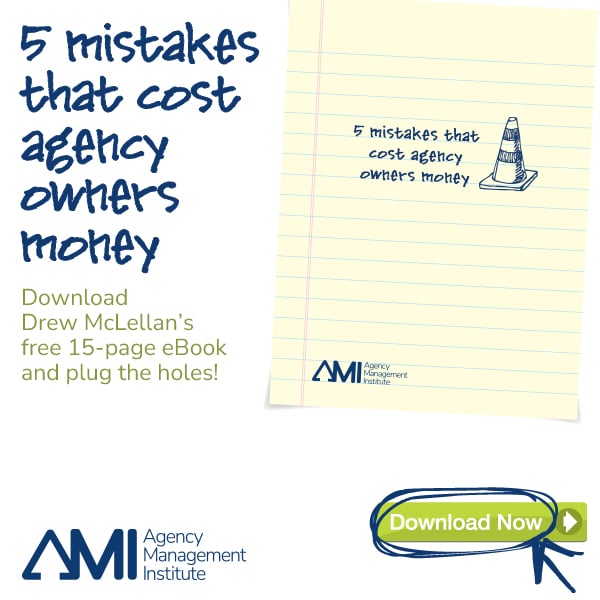Back in the “Mad Men” days, only writers and artists were held accountable for driving an agency’s creativity. Today, that dynamic has expanded to include just about everyone.
Whether it’s the account services team bringing fresh ideas to clients, the business development team finding new ways to engage with prospects, or creative services producing content, everyone has to be creative for the agency to succeed. Individual contributors also must be able to tie their creative efforts to measurable ROI.
Why is creativity so important? Because for agencies, creativity is currency. The successful execution of good ideas separates top agencies from closed shops. The barriers to entry for marketing are lower than ever — anyone with an idea and an hour can build a website or whip up a logo. Agencies must communicate their value proposition as the owners of the best ideas and know how to measure that value.
But creativity alone is not enough. Agencies and the people within them must be creative on demand. To do that, every department and every employee must become part of a culture that excels at creative problem-solving.
Bringing New Ideas to the Table
Often, creativity is talked about like it’s a magical ability of the chosen few — something we have little control over that strikes at random. But Jason Keath, founder and CEO of Social Fresh Conference, says universal creativity is not as hard to achieve as some entrepreneurs would imagine.
I spoke with Keath recently, and he said that creativity is less about inspiration and more about learning to solve problems. “Anyone can be creative,” he says, adding that creativity is a process that we fail to teach in schools or in business environments.
This is good news, though, because it means creativity isn’t something the muses bestow upon you. Rather than wait patiently for lightning to strike, you simply must learn the process. If you want to teach people to become creative on their own and within a group, a lot of it comes down to management, Keath notes.
The first step in bringing new ideas to the table is banishing the notion of bad ideas — early in the creative process, bad ideas are an essential building block to create a better final product. A lot of times, a bad idea can trigger a better idea.
“One person might have a bad idea he considers to be the obvious solution, but he doesn’t mention it to avoid looking stupid,” Keath says. “However, as obvious as that solution might seem to one person, it probably hasn’t occurred to 80 percent of the people in the group. Plus, even the most obvious solutions are useful to put on the board because connecting to that is another idea.”
One tactic to encourage your team to get over their fears of offering “bad” ideas is to require anonymous ideation prior to creative meetings. This allows people who don’t normally consider themselves creative to contribute to the solution. “Judgment kills great ideas,” Keath says. “To preempt judgment, ask people to come to the meeting with 10 or 20 possible solutions to the problem. Have the person organizing the meeting anonymize the answers, and suddenly, ideas can be discussed on their own merit without fear of rejection.”
4 Tactics for Cultivating On-Demand Creativity
If agency leaders want to infuse creativity and new ideas into their agencies — and communicate that value proposition to clients — the path is twofold. First, leaders and team members must learn to take new steps as individuals. Second, agencies need to create an environment that enables creative individuals to collaborate. Here’s how to accomplish both:
1) Encourage individual growth.
Most creative people have a core competency that they build upon by brushing up against life. This means seeking out new experiences and connecting them to the areas they know most about.
That connection between the known and the unknown encourages people to seek out new experiences rather than hide within their comfort zones. A hiker might not know much about photography, but learning to take better pictures of hiking spots combines a known pursuit (hiking) with an unknown (photography) and allows the person to explore new ideas without feeling overwhelmed.
2) Pursue new experiences.
To achieve great output, you first need great input. According to principals of neuroplasticity, experiencing new things enables us to make connections and think in ways that would have previously been impossible. Experiences big and small can inform our decisions in surprising ways down the road.
Think about it like this: You’ve just returned home from a long trip. You need to cook something to eat, but you’ve been gone for a while and the kitchen is bare. Now, compare that to a kitchen that has been stocked with a variety of ingredients. Creativity works similarly: It’s much easier to create something interesting when we have a lot of raw materials to work with.
3) Always present two ideas: one safe, one scary.
We constantly hear CMOs complain that their agencies are phoning it in. Same old ideas, same old approaches, same old results. Of course, CMOs share the blame by selecting safe ideas, but that doesn’t mean their point isn’t valid.
No matter how many times your agency’s wacky idea gets shut down, you need to continue to bring new thoughts to your presentations. The unusual idea won’t get selected often, but bringing something new to the table shows clients that you’re willing to do things differently. And if a client decides to go with the crazier idea, that provides an opportunity for an agency to showcase its talents.
4) Host company outings.
Most of us haven’t had a field trip since high school, but they can still provide meaningful learning experiences for adults. Whether it’s catching a new animated movie, visiting the art museum, strolling the zoo, or something completely off the beaten path, getting your team out of the office together in a low-pressure environment can generate surprising discussions. The more inputs people have — especially when they share those inputs outside of work — the more creative connections they can forge.
We love to tell clients to think more broadly about their goals, but if we don’t mix up our own experiences, we fall prey to the same traps we ask them to avoid. By seeking opportunities to broaden our own horizons and building processes that facilitate creative discussions, we can transform our agencies into creative powerhouses that are capable of handling any challenge.
This article written by Drew McLellan was originally published on HubSpot.






